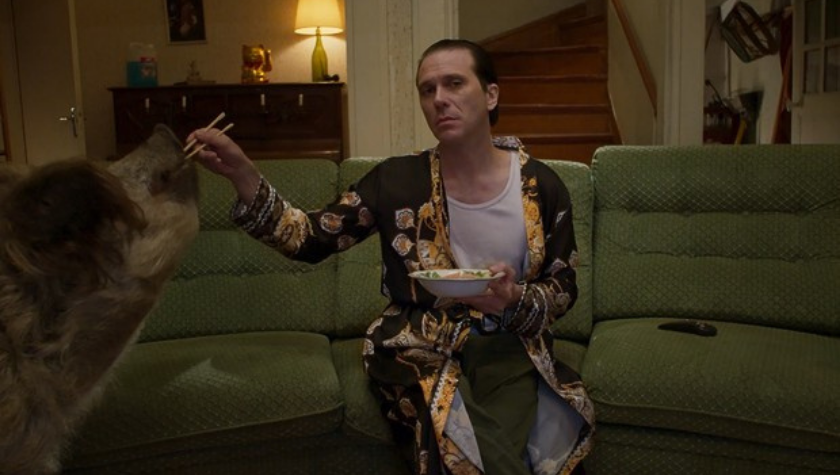Sing Me A Song' Chronicles a Buddhist Monk's Struggles With Internet Temptations
January 1, 2021
Sing Me A Song is a fascinating examination of what happens when an isolated community slowly but surely is exposed to the outside world through the internet and television... To the point that young monks are now aware of internet dating. While one may think, why would a young monk be interested in internet dating in the first place? The answer is quite simple: the internet heightens the experience of being a young teenage male regardless of location, life experience, or religious background—the internet is an equalizer and tantalizing drug for all.
Documentarian Thomas Balmès has spent years of his life studying what happens to a community when the outside world is invited in. Balmès examined these transitions through a remote monk community in a Bhutanese village in the Himalayas, namely through the eyes of a young monk named Peyangki. Balmès’ previous film Happiness, in what could be called a necessary precursor to Sing Me A Song, follows Peyangi at age eight when he is still without even electricity. Sing Me A Song begins with a reminder of what Peyangi’s life was like back then as he muses what life will be like when roads and electricity finally reach him, but he is also still just plain happy running through the mountains keeping up with his monk activities.
Balmès received remarkable access to Peyangi’s monk community then and now, almost by chance. He stated that when he first met Peyangi, the elder monks were enduring a time of reconstruction for their living space and their strict rules were a little lax due to the disruption of their daily life. Balmès admits that, like with many documentaries, luck and timing played a part as another filmmaking team had almost wrecked access for everyone by sitting in a chair in the monastery meant only for the King of Bhutan.
The remarkable connection Balmès has with Peyangi is evident throughout the film, and when the documentarian returns to check up on the young monk, Peyangi is open with Balmès about experiencing the restlessness of a typical teen with the added pressure of having grown up considered to be a chosen one to become a sacred lama. Peyangi also now has an additional device he worships beyond Buddha — his cellphone. And he is not alone in this, as his young monk cohort all plays games on their devices through prayers.
But what might feel most remarkable about Sing Me A Song is that none of it is scripted. This is simply the journey of a young man discovering the world and himself. Gorgeous moments of contemplation, to the sharing of karaoke-style songs with a pretty girl through WeChat, to eerie obsessions with violent video games, feel like something planned, yet all the while innocent and fresh. Balmès planned to make something like nothing he’d done before, and he achieved the feeling through “cinematic language usually only dedicated to fiction,” he states. “We did use heavy equipment and were not flies on the wall. We were totally present and people knew we were there. We had two, three or four crew members in the same room at the same time. Also, when following the same character (Peyangki) for ten years, we had some trust. But I did try to anticipate what he was going to do, and be there in the right moment… I wanted to play with this kind of wondering is it real, or not real — I like to play with everything you can do in the genre of documentary.”
What Balmès could perhaps not anticipate was how much Peyangki’s curiosity about the allure of a possible relationship would drive the narrative. Balmès eventually had to split up his crew to be able to get Peyangki’s WeChat love interest’s side of the story, as she dwells in the nearby, more urban town of Thimphu, barely carving out a living as a singer in a male-frequented karaoke style club. Ugyen is an alluring character going through her own coming of age struggles that, despite her intimate WeChats with Peyangki, she decides to keep secret from him until he takes a risky journey to the city to see her.
In the city, Peyangki takes part in an exploration of what it feels like to live life not as a monk: gorging on Chinese food, dressing like an ordinary civilian, and indulging in hours of video games. What Peyangki hadn’t anticipated was that life with total freedom can also create total loneliness, even with your cell phone constantly in your hand. Peyangki utters to a monk friend who comes to retrieve him that he is worried he has gone too far from Buddha to go back, and one wonders if this will be a struggle Peyangki grapples with in the future (and if Balmès will again return to Bhutan to find out). Balmès muses, “I have no idea where Peyangki would take me ten years from now… Maybe he’ll start his own monk TV channel — I think he will always have one foot in tech.”
The allure of technology is absolutely the third co-star of the film and Balmès admits that overall, he has a pessimistic view of tech affecting any of us for good. “It disrupts your capacity to concentrate and shortens your capacity to do other things, even interacting with others. There is not a single person in the whole world not impacted by it. I hope the film raises discussions about that.”
Perhaps ultimately, Peyangki learns the dangers of tech more quickly than your average teen through his journey of self-exploration in the city. Balmès says Peyangki now spends his days casting and directing his fellow monks in his own productions and tiny films he shoots on his cell phone. “He wants to use his phone in a more active and creative way.” If the world gets to eventually experience Peyangki’s original monk TV, maybe the disruption of life by technology in the previously protected Himalayas might be worth it.
Written by: Lindsay Stidham
Lindsay holds an MFA in screenwriting from the American Film Institute. She has overseen two scripts from script to screen as a writer/ producer. SPOONER, starring Matthew Lillard (SLAMDANCE), and DOUCHEBAG (SUNDANCE) both released theatrically. Most recently Lindsay sold PLAY NICE starring Mary Lynn Rajskub. The series was distributed on Hulu. Recent directing endeavors include the Walla Walla premiering (and best screenplay nominated) TIL DEATH DO US PART, and the music video for Bible Belt’s Tomorrow All Today. Lindsay is currently working on an interactive romcom for the production company Effin' Funny, and a feature film script for Smarty Pants Pictures. Lindsay also currently works as an Adjunct Screenwriting Faculty member at USC’s School of Cinematic Arts. You can follow her work here: https://lindsaystidham.onfabrik.com/



